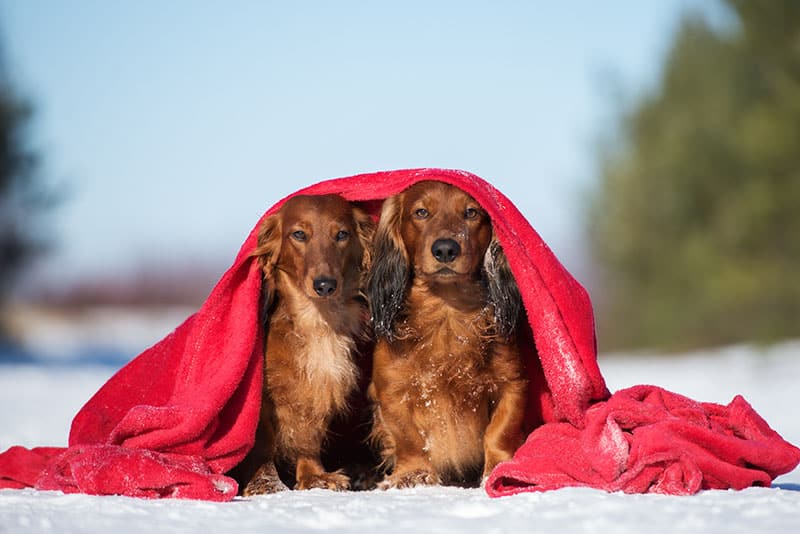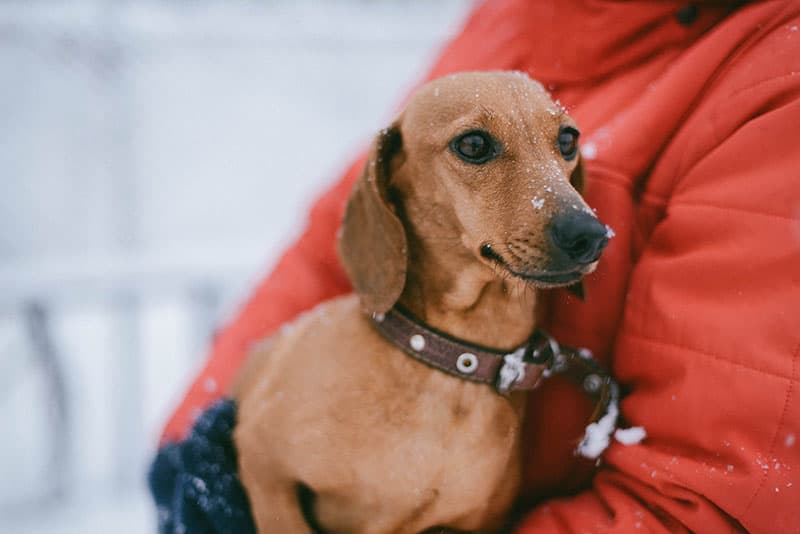Do dachshunds get cold easily?
Dachshunds, known for their small size, are highly sensitive to the cold. With their thin coat of fur, even Dachshunds with long hair lack the necessary protection, as it is neither thick nor layered.
One common misconception is that dogs, regardless of breed, can withstand hours in the cold. While this may be true for certain breeds, most dogs require extra care to ensure their well-being and happiness during the coldest months.

Why do short-legged dogs get colder than other dogs?
Short-legged dogs, such as Dachshunds, have a closer proximity to the ground compared to other breeds. As a result, they are more susceptible to the cold, not only from the air but also from the ground.
Therefore, it is crucial to pay special attention to Dachshunds when they are outdoors in cold weather. Additionally, their long bodies provide a larger surface area, which further increases their vulnerability to the cold.
Dachshunds, like any other dog, can endure temperatures above 40°F. However, anything below this temperature is uncomfortable for humans, let alone dogs. Hence, it is important to provide proper care and attention to Dachshunds when they are exposed to cold temperatures.
Winter hazards for dachshunds
Dogs, much like humans, can suffer from adverse effects caused by cold weather conditions. It is important to take measures to prevent and recognize these issues. Exposure to extreme cold can lead to frostbite in their ears, paws, and tails, resulting in pain, discomfort, and even tissue damage in severe cases.
Frostbite can occur in dogs when they are exposed to prolonged cold temperatures. The affected skin becomes extremely pale, often with a blue or white hue due to reduced blood flow. Severe frostbite can result in painful injuries and may even require the amputation of the affected body part.
Another condition to be aware of is hypothermia, which occurs when the dog’s body temperature drops below normal levels. This can cause shivering, lethargy, and confusion. Hypothermia can also impact the dog’s central nervous system, heart rate, and immune system.
The main signs of hypothermia are:
- Muscle stiffness
- Slow and heavy breathing
- Weakness
- Lethargy
To prevent hypothermia, it is important to avoid prolonged exposure to cold temperatures, especially for hounds considered at risk. Puppies, older dogs, and those who are sick are more susceptible to losing body heat quickly and are at a higher risk of hypothermia.
If you find it necessary to wear a coat outside, your Dachshund is likely feeling the cold too, and could benefit from a properly fitting coat. In climates with frequent snow and ice, hound booties or paw protectors may be helpful. Dachshund owners should be aware of the signs that indicate their dog needs to come inside and warm up.

Signs your dachshund is feeling cold:
During the winter months, it’s important to closely monitor your pet’s well-being to ensure their comfort and health. Watch out for the following signs:
- Trembling or quivering
- Tail tucked between the legs
- Vocalizing with whines or whimpering
- Actively seeking warmth near heaters or other heat sources
- Displaying altered behavior, such as signs of anxiety or discomfort
- Showing hesitation or reluctance during walks, seeking shelter instead.
If your pet continues to exhibit these symptoms despite efforts to warm them up, we strongly advise consulting your local veterinarian for further assistance.
Protecting Your Dachshund from Cold Weather
Although dachshunds typically prefer warm and cozy environments, it is completely acceptable for owners to take them for walks in the snow. However, it is important to take precautions to keep them safe. Make sure they are properly bundled up with a sweater or coat and protect their paws with dog boots or a paw protector balm. Cold temperatures, snow, and icy pavements can be harmful to a dachshund’s paws.
If you notice that your Dachshund is still shivering or exhibiting signs of being cold, despite taking these precautions, it may be necessary to take them to the vet for a general check-up. Your dog may be experiencing a medical issue that affects their ability to regulate body heat. The earlier you address this, the better it will be for their well-being.
If your Dachshund is a senior dog, they may benefit from wearing comfortable garments even indoors. Age can also impact a pet’s ability to regulate body temperature. Although it may be challenging to get your dog accustomed to wearing new clothing at first, you will find that once they experience the warmth and advantages, they will come to appreciate their cozy coats.
Here are some great winter protection gear options for your dachshund:
Here are more Dog Clothes that fit Dachshunds!
Conclusion
As responsible owners of dachshunds, we must prioritize their well-being and ensure their warmth and comfort during colder weather. By following the tips provided in this guide, you can create a safe and cozy environment for your dachshund, enabling them to fully embrace the joys of the winter season.
Remember, a content and comfortable dachshund is a lively and healthy companion who will bring endless joy and affection to your life throughout the year.
Related post: Dachshund Care: A Complete Guide to Keep Your Dachshund Happy and Healthy





